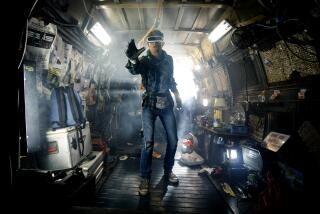THE CUTTING EDGE: COMPUTING / TECHNOLOGY / INNOVATION : Virtual Reality Takes on a Third Dimension
- Share via
Cyberspace was never meant to be limited to a measly two dimensions.
As envisioned by its science-fiction progenitors, space as we know it in the corporeal world was vital to the virtual form of existence that would take shape on-line.
But constrained by technology--and perhaps a certain dearth of imagination--the electronic universe that millions of computer users now visit regularly has remained plastered to a flat screen.
Until now. Driven by advances in networking technology, a host of high-tech heavyweights and several small start-ups have begun injecting cyberspace with 3-D. And the spatial metaphor, if it catches on, could radically transform the on-line experience.
For one thing, proponents say, it will make cyberspace a far more intuitive place for an inexperienced computer user to get around in.
Walking through the door of a virtual library and looking for a book on a shelf, for example, could be a less intimidating prospect for a newbie Net surfer than pointing and clicking on some random icon and being dizzily transported who-knows-where to the source of the information.
3-D could also alter the picture for those trying to sell stuff on the Net. Theater owners can use the technology to place a ticket buyer in any seat in the house, to check out the view. One 3-D demonstration shows instructions for assembling a desk that let you rotate the diagram and see where the screws are supposed to go.
But perhaps more profound, the ability to inhabit a common space with others changes the very nature of a communication medium whose major virtue has been its ability to collapse distance.
Until now, the ability to form relationships with people across the country or access information from databases on the other end of town has always come at the expense of the intimate sense of being in the same place with someone.
When this is no longer the case--when you can choose your own “avatar” to represent yourself and interact with people in virtual space almost as you would in real space--3-D evangelizers predict, the result will be the formation of stronger virtual communities and forms of expression that don’t come naturally in the medium as it currently exists.
“The Internet needs to be more like your grandmother’s house,” says Mark Pesce, co-author of a new protocol called Virtual Reality Modeling Language, or VRML, which allows users to create and navigate through 3-D spaces on the Net.
“VRML lets us sensualize our data,” says Pesce, who has been known to give seances before demonstrating the software. “If the Internet is going to be the primary communication medium of the 21st Century, then it has to allow us to express the things of memory, the things of emotion, the things that we really care about. And for that, 3-D just works better.”
Indeed, VRML and its fledgling applications are the buzz of the Siggraph 95 convention at the Los Angeles Convention Center this week, where 30,000 computer graphics professionals are gathered to share the latest information on technology and communication.
At the show Tuesday, IBM and Worlds Inc. announced an alliance to promote an expanded standard for VRML, to fuel the appetite for “virtual worlds” on the Internet.
As a demonstration of what the World Wide Web might look like in 3-D, the companies showed two friends browsing on-line a photo exhibit at the Los Angeles Public Library together, typing comments to one another as they toured the gallery.
San Francisco-based Worlds Inc. is expected to announce a contract with Visa to create on-line bank offices for the credit company’s member banks, where customers could log on and talk to a representative about their accounts.
Silicon Graphics Inc. set up 20 kiosks around the convention center, where attendees can navigate through a virtual map of the show floor, or talk to each other through a high-speed video conferencing network (still impractical for personal computers).
SGI, which contributed much of the computer code for VRML, is also introducing new tools to enable the creation of 3-D sites on the Web.
At the Microsoft booth today, architect David Colleen will be demonstrating “Virtual SOMA,” a 3-D model of San Francisco’s South of Market Street area that Colleen’s firm has modeled in VRML, giving users the ability to walk down actual San Francisco streets and explore the neighborhood.
Microsoft, SGI and IBM will all be showing different browser programs that allow users to view Internet sites built with VRML. “We think this will give more people a reason to use our networks,” said Willy Chiu, multimedia technology director for IBM’s software division. “Anything that does that, in the long run, will provide us with more revenues.”
While the executives of the major computer companies may not have the visions of cyberpunk novelists in mind, for many of the 3-D proponents, the emergence of VRML is a classic case of life imitating science fiction.
The “metaverse” in Neal Stephenson’s “Snow Crash,” where citizens engage in virtual-world interactions that have ramifications off-line as well, is the most frequently used shorthand to describe the future of 3-D cyberspace. Pesce says William Gibson’s “Neuromancer” was his inspiration to begin pushing for a common VRML standard.
“I think we’re all inspired by the science-fiction projections of all of this,” says Lisa Goldman, president of a San Francisco-based start-up called Construct, which specializes in building virtual spaces.
Adds Rikk Carey of Silicon Graphics: “I don’t know how up you are on books like ‘Snow Crash.’ But what VRML does is it gives you a sense of place. And what happens after that is a real cognitive shift. This is cyberspace.”






